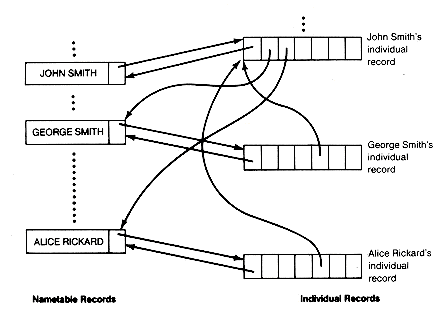
To find answers to relationship questions quickly, you must be able to localize the search and get to the relevant records without considering all of them. You can, if you somehow link records together in a meaningful way. The problem deals with family relationships. Suppose you set up a record in memory to correspond to each individual name in the system, each record having seven fields, five of the fields containing pointer information. The seven fields of each individual's record will be nameptr, fnameptr, mnameptr, siblingptr, childrenlist, sex, and birthdate.
You will also have a table of names, called nametable. Each record of nametable will have a name and a recordptr field. The recordptr field contains a pointer to the individual record of the person whose name appears in the name field. By searching the nametable for a name, we get the pointer to the corresponding individual's record. Following the trails (pointers) from the record, we can retrieve the data needed to answer questions.
Figure 6.5 depicts the form of the two kinds of records. In memory the collection of nametable records will be stored separately from the collection of individual records.
The memory would appear as shown in Figure 6.6, after the data has been input. The childrenlist field of a record f contains a pointer to the first record on the list of children of the individual represented by f. The siblingptr field plays the role of a link field for records on the list of siblings of f. The different lists are intertwined as shown in Figure 6.7.
In Figure 6.7 records f and m are husband and wife, so their children-list pointers are identical. It might be convenient to keep the lists of children in order by birthdate or to make them circular, so that the null pointer signifying the last record would instead point to the first record of the list.


If the assumptions about an "ideal" world were violated, it would be possible to have shared records, and loops could even appear. With the assumptions, the lists are list-structures. The main list of any sublist consists of siblings. All records are complex, with sublist fields (childrenlist fields) pointing to sublists representing children of the individual represented by the complex record. Sublist sharing, however, does occur because the fathers and mothers share the lists of children.
